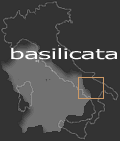POTENZA
Potenza is a centre of the Basento Valley
and capital of Basilicata.
History
Its birth probably came about during the Roman era (IV century
BC), even though it seems proven the existence of a prior Potentia
close to Vaglio. The ancient centre (X century BC), was probably
destroyed by the Romans and its inhabitants left and founded
the present day centre of habitation in the Murate locality
(IV century BC).
It became a Municipium (I century BC) and enjoyed a period of
development due to its central geographic position. However,
during the Imperial Era it progressively lost its importance.
It was plundered by the Goths of Alarico during 402 AD and
became an Episcopal Seat (V century).
After the brief Ostrogoth Reign (496-535) it passed for a
short period to the Byzantines and finally to the Longobard
Dukedom of Benevento (VI century).
The arrival of the Normans (XI century) coincided for Potenza
with a period of economic and town planning development, which
also continued with the Swabians. For this reason, its inhabitants
opposed the descent in Italy of the Angioiniansans by leading
the Ghibelline Revolt of 1268.
Carlo 1 d’Angio’s response was besiegement and
devastation (1269) of the central habitation. This wound was
aggravated by an earthquake in 1273. It was rebuilt and given
in fief to Pipino by the Angioiniansans.
It was then property of the following families: Sanseverino,
Voivoda, Guevara (1435), Lannoy and finally the Loffredo family,
who kept it until the end of feudalism (1806).
During these centuries, Potenza demonstrated its Republican
vocation by participating in the anti-Spanish motions (1647),
the Republican motions of 1799 and the Renaissance ones of
1848. It was also the first city of Basilicata to rebel against
the Bourbons during 1860.
It was bombed during the Second World War (1943).
A visit to the City
One can access the centre of the City through Via Pretoria,
around which one can visit the major buildings of interest:
the Medieval Church of the Trinità, S. Michele Arcangelo
and S. Francesco, the Stabile Theatre, Palazzo Loffredo which
hosts the National Archaeological Museum “Dinu Adamesteanu”
and the Duomo. The latter is dedicated to Bishop Gerardo and
was built in only three years around the 1200s.
In the vicinity of the railway station, one can visit the
Medieval Church of S. Maria del Sepolcro and the Provincial
Archaeological Museum.
Only a villa from the Imperial Era with mosaics situated in
the Malvaccaro locality remains from the Roman period, and
a Roman bridge on the Basento River, in the lower part of
Potenza.
Places of interest
The San Gerardo of Potenza Cathedral (1197-1200); Ex castle
Tower; Trinità Church (XIII century); Santa Maria del
Sepolcro Church (1266); San Francesco Church (XIII century);
San Michele Arcangelo Church (XI-XII); Palazzo Loffredo (XVII
century); Palazzo del Governo; Palazzo Barili; Malvaccaro
Roman Villa; San Vito Roman Bridge; Stabile Theatre constructed
in 1856; Pantano Lake.
Events
Turkish Parade on 29th May; Feast of San Gerardo on 30th
May; Feast of SS. Redentore in the Montocchio district on
1st June; Feast of S. Antonio in the S. Nicola district on
1st June; Feast of S. Antonio in the Barrata and S. A. La
Macchia districts on 8th June; Feast of S. Giovanni Bosco
in the Risorgimento district on 22nd June; Feast of SS. Pietro
and Paolo in the Francioso district on 29th June; Feast of
the Sacra Famiglia in the Rossellino district on 29th June;
Feast of Gesù Maestro in the S. Maria district “Prince
of Pemonte” on 29th June; Feast of the Madonna delle
Grazie in the Lavangone district on 6th July; Feast of the
Madonna del Carmine in the Cozzale district on 13th July;
Feast of San Rocco in the San Rocco district on 16th August;
Feast of S. Raffaele in the Canaletto district on 24th August;
Feast of the Sacro Cuore di Gesù on 24th August; Feast
of the Madonna delle Grazie in the S. Luca Branca district
on 31st August; Feast of Maria SS Immacolata in the Cocuzzo
district on 7th September; Feast of Santa Cecilia in the Poggio
Tre Galli district on 14th September; Feast of Beato Bonaventura
in the Malvaccaro district on 21st September; Feast of S.
Michele Arcangelo in the Bosco Piccolo district on 28th September.
|
 This is a file from the Wikimedia
Commons. Click the pic to see its description page and licensing.
This is a file from the Wikimedia
Commons. Click the pic to see its description page and licensing.




